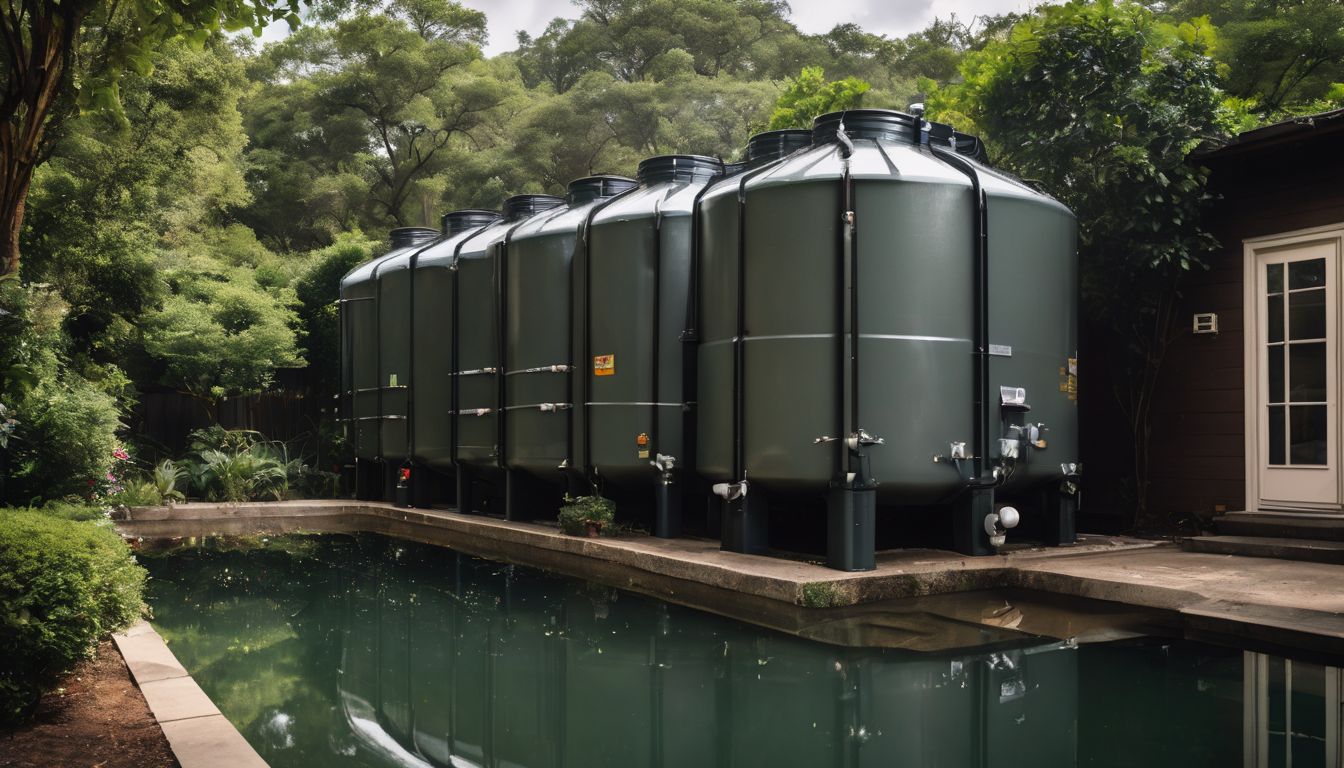You want to shop with a clear conscience, right? More than 80% of consumers now look for sustainable options. This guide promises to help you find and support local businesses that care for our planet.
Let’s make a difference together!
Key Takeaways
- Creating a guide to local sustainable businesses encourages responsible shopping and supports the economy while caring for our planet.
- A sustainability program includes conducting audits, using frameworks, and involving employees to ensure eco-friendly practices are integrated into all business operations.
- Engaging with employees through green teams and strategies boosts their commitment to implementing sustainability in the workplace.
- Identifying and partnering with local sustainable businesses can lead to stronger community ties, reduced environmental impact, and promotion of conservation efforts.
- Support from consumers for these businesses is key; by making informed choices we help establish a thriving market for sustainable goods and services.
Understanding Sustainability and the Triple Bottom Line
Sustainability is the practice of meeting current needs without compromising the ability of future generations to meet their own needs. Understanding and implementing the Triple Bottom Line – people, planet, profit – is essential for sustainable business practices.
Completing a B Impact Assessment and conserving natural capital are key components in understanding sustainability.
Definition of sustainability
Sustainability refers to meeting our own needs without compromising the ability of future generations to meet theirs. It encompasses a broad approach that considers environmental, social, and economic dimensions—ensuring a balance between growth and conserving our planet’s resources.
Businesses play a crucial role in this by adopting practices that reduce their environmental impact and contribute positively to society.
To be sustainable, companies must integrate eco-friendly methods into their operations. This means using materials that can be replenished or recycled, minimising waste production, and reducing energy consumption.
It’s about responsible management of resources while also ensuring the business thrives economically. By choosing sustainability, businesses not only support conservation efforts but also strengthen community ties and foster ethical practices that benefit all stakeholders.
Importance of the Triple Bottom Line
The Triple Bottom Line is crucial for small businesses committed to sustainability. It considers not only financial performance but also social and environmental impacts. This broader view helps businesses make decisions that benefit people, the planet, and profits.
By completing a B Impact Assessment, businesses can measure and improve their impact on all three bottom lines: people, planet, and profit.
Conserving natural capital plays a vital role in sustainable business practices. It involves reducing waste, using renewable resources, and minimising negative environmental impacts.
This approach supports responsible consumption while promoting long-term economic growth. Implementing the Triple Bottom Line framework is essential for businesses aiming to build an eco-friendly future.
Completing the B Impact Assessment
Conducting a sustainability audit is the initial step in assessing a company’s social and environmental impact. It provides valuable insights into areas for improvement and aligns with the importance of the Triple Bottom Line.
Completing the B Impact Assessment, an essential tool for evaluating business practices, offers a comprehensive framework to measure and improve a company’s impact on workers, community, environment, and governance.
The assessment covers key aspects such as energy usage, waste management, employee benefits, diversity policies, community involvement, and transparency – all vital elements in building a sustainable business that supports conservation efforts.
Identifying local sustainable businesses can be facilitated by considering their completion of the B Impact Assessment as it serves as an indicator of commitment towards ethical business practices.
Conserving natural capital
Conserving natural capital involves protecting and preserving the Earth’s resources, such as water, soil, air, plants, and animals. By reducing waste and pollution, using renewable energy sources, and promoting sustainable practices in business operations, we can ensure that natural resources are available for future generations.
Implementing green initiatives like energy-efficient technology and sustainable supply chains helps to minimise environmental impact while also benefiting local ecosystems.
Supporting local businesses that prioritise eco-friendly operations is crucial in conserving natural capital. By purchasing from these businesses and partnering with them, we contribute to the preservation of our environment while fostering a thriving local economy.
How to Get Started with Sustainability
Conduct a sustainability audit, use a framework, and establish a program to overcome challenges and implement green practices in the workplace. Ready to take your business to the next level of sustainability? Learn more by reading the full blog!
Conducting a sustainability audit
To conduct a sustainability audit, begin by reviewing current business practices against sustainable benchmarks. This will help identify areas for improvement and establish a baseline for future progress. Next, assess energy usage and waste management to determine how they align with sustainability goals. Then, evaluate supply chain processes and materials to ensure they meet eco-friendly standards. Consider the impact of transportation and logistics on the environment as well, and explore opportunities for improvement in these areas. Finally, engage stakeholders at all levels of the business to gather input and support for implementing sustainable changes company-wide.
Using a sustainability framework
To develop a sustainable business, start by using a sustainability framework. This involves creating a structured plan to integrate sustainable practices into all aspects of your business operations.
Begin by identifying key areas where changes can be made, such as energy usage, waste reduction, and supply chain management. Implementing this framework will require collaboration across different departments within the company to ensure that sustainability goals are aligned with overall business objectives.
By using a sustainability framework, businesses can establish clear targets for reducing environmental impact while also improving resource efficiency and long-term financial performance.
When establishing a sustainability program for your business, it’s essential to incorporate strategic planning and regular assessment of progress. Developing an effective sustainability framework requires commitment from leadership and active participation from employees at all levels.
Establishing a sustainability program
To establish a sustainability programme, follow these steps:
- Assess the current state of your business and determine areas for improvement in terms of environmental impact reduction and eco-friendly practices.
- Create a sustainability framework that outlines specific goals, action plans, and accountability measures to guide the implementation of sustainable practices throughout your business operations.
- Develop a clear and comprehensive sustainability programme that aligns with your company culture, focusing on small business sustainability and improvement of employee engagement.
- Implement green practices in the workplace, such as reducing waste, minimising energy consumption, and promoting eco-friendly purchasing decisions.
- Incorporate sustainability into all aspects of the business, including product development, supply chain management, and customer relations.
Overcoming challenges
Starting a sustainable business may come with its fair share of challenges, but overcoming these obstacles is crucial for success. Below are the key challenges and how to address them:
- Access to capital: Securing funding for sustainable initiatives can be challenging. Consider seeking out grants, loans, or investors that specifically support eco-friendly businesses.
- Changing consumer behaviour: Educating consumers about the value of sustainability and making eco-friendly choices can be a hurdle. Utilise marketing strategies that highlight the benefits of sustainable products and services.
- Regulatory compliance: Navigating complex environmental regulations may seem daunting. Seek legal advice from experts in environmental law to ensure compliance and minimise risks.
- Supply chain sustainability: Ensuring that suppliers align with your sustainability goals can be demanding. Develop clear criteria for selecting eco-conscious suppliers and establish open communication channels to foster collaboration.
- Employee buy-in: Encouraging employees to embrace sustainable practices may require a shift in company culture. Offer training, incentives, and recognition programmes to engage and motivate staff.
Implementing green practices in the workplace
To implement green practices in the workplace, start by conducting an energy audit to identify areas for improvement. Upgrade lighting to energy-efficient LED bulbs and install motion sensors to reduce unnecessary usage. Introduce recycling bins for paper, plastic, and glass to encourage waste reduction. Encourage the use of reusable mugs and water bottles by providing designated refill stations.
Incorporating sustainability into all aspects of the business
Transitioning from implementing green practices in the workplace to incorporating sustainability into all aspects of the business is essential for a comprehensive eco-friendly business plan. Here are key steps to ensure sustainability permeates every part of your company:
- Integrate sustainable sourcing methods into your supply chain, seeking local, ethically sourced materials and products.
- Implement energy-efficient technology and practices, such as LED lighting, low-flow water systems, and renewable energy sources.
- Develop a waste reduction strategy by promoting recycling, composting, and reducing single-use plastics throughout your operations.
- Foster a culture of sustainability within your company by providing training on eco-friendly practices and encouraging employee involvement in environmental initiatives.
- Incorporate sustainable packaging solutions for products and shipping to minimise environmental impact.
- Engage with local communities through outreach programmes or partnerships that support environmental conservation efforts.
- Regularly evaluate the sustainability performance of all business functions and make necessary adjustments to enhance eco-friendliness.
Engaging Employees in Sustainability
Create a green team and implement strategies to increase employee engagement in sustainability efforts. This will help promote a culture of environmental consciousness within the workplace.
Forming a green team
To form a green team, follow these simple steps:
- Identify employees who are passionate about sustainability and willing to lead initiatives within the company.
- Encourage diverse representation from different departments to bring varied perspectives and expertise to the team.
- Establish clear objectives for the green team, such as reducing energy consumption, implementing recycling programs, or sourcing sustainable suppliers.
- Provide resources and support for the team to research, plan, and implement sustainable practices within the business.
- Foster open communication and collaboration among team members to generate new ideas and drive positive change.
Strategies for increasing employee engagement
To increase employee engagement in sustainability efforts, consider the following strategies:
- Create a clear vision: Communicate the importance of sustainability and how it aligns with the company’s values and goals.
- Provide training and education: Offer workshops, webinars, or resources to help employees understand the impact of their actions.
- Encourage participation: Involve employees in decision-making processes, seeking their ideas and input on sustainability initiatives.
- Recognise and reward: Acknowledge and appreciate employees who actively contribute to sustainable practices within the workplace.
- Foster a sense of ownership: Empower employees to take ownership of sustainability initiatives within their respective roles.
- Develop green teams: Establish teams dedicated to driving sustainable practices and initiatives throughout the organisation.
- Offer incentives: Consider providing incentives such as bonuses, extra time off, or other rewards for exemplary sustainable actions by employees.
Supporting Local Sustainable Businesses
Supporting local sustainable businesses is crucial for reducing environmental impact and promoting a more eco-friendly community. By identifying and partnering with these businesses, we can work towards a more sustainable future.
Importance of supporting local businesses
Supporting local businesses is crucial for fostering a sustainable community. By choosing to buy from local sustainable businesses, you contribute to the growth of your local economy and reduce the environmental impact associated with transporting goods over long distances.
Moreover, supporting these businesses often means supporting eco-friendly practices and reducing carbon emissions. This can lead to a more vibrant and resilient community that values sustainability.
Identifying and partnering with local sustainable businesses can also lead to mutually beneficial relationships. These partnerships can help raise awareness about environmentally friendly products and services while building a network of like-minded individuals striving towards a common goal – promoting sustainability.
Identifying local sustainable businesses
To support sustainable practices in your area, you can begin by identifying local businesses that align with your eco-friendly values. Look for businesses that prioritise environmental responsibility and have a clear commitment to sustainability. Consider the following when identifying local sustainable businesses:
- Research local directories and online resources dedicated to sustainable businesses in your area.
- Seek out certifications such as B Corp, Fair Trade, or organic certifications when evaluating potential businesses.
- Engage with local business associations or chambers of commerce that promote sustainability initiatives.
- Evaluate the products and practices of potential businesses to ensure they align with your environmental values.
- Consider visiting farmers’ markets, craft fairs, or eco-friendly expos to discover small-scale sustainable businesses.
- Connect with like – minded individuals or groups who can recommend local sustainable businesses based on their personal experiences.
Partnering with and promoting local sustainable businesses
After identifying local sustainable businesses, the next step is to partner with and promote them. This not only supports the local economy but also encourages the growth of sustainable practices. Here are some ways to effectively partner with and promote local sustainable businesses:
- Collaborate on events and initiatives that highlight sustainability, such as eco – friendly fairs or workshops.
- Feature local sustainable businesses in your marketing materials and social media platforms to raise awareness.
- Establish partnerships for joint promotions, offering discounts or incentives for customers who support both businesses.
- Include products from local sustainable businesses in your offerings, showcasing their commitment to eco-friendly practices.
- Host collaborative projects or initiatives that engage the community in supporting sustainability efforts.
Conclusion
Supporting local sustainable businesses is crucial for the environment. Identifying and promoting these businesses helps to build a more sustainable community. By engaging with local eco-friendly enterprises, we can all contribute to a healthier and greener future.
Creating a guide to local sustainable businesses allows us to make informed choices that positively impact our surroundings and economy.
FAQs
1. What is a guide to local sustainable businesses?
A guide to local sustainable businesses helps you find ecologically conscious companies in your area that operate with the planet and community in mind.
2. How do I get started on creating a sustainable business plan?
Begin by outlining eco-friendly practices, considering company culture improvement, and detailing steps for sustainability programme development suited for small or start-up green businesses.
3. Why should I consider developing a sustainable business?
Developing a sustainable business isn’t just good for the earth; it also meets growing consumer demand for responsible operations and can help enhance your brand’s reputation.
4. Can any business become eco-friendly?
Yes! With dedication to making positive changes, any size of business can implement an ecofriendly guide and adopt substantial sustainability measures within their operation.
5. What are the key elements of a beginner’s guide to starting an ecofriendly business?
A beginner’s guide should cover essentials like choosing environmentally friendly materials, crafting a comprehensive sustainability plan, and integrating these principles into every aspect of your startup.





